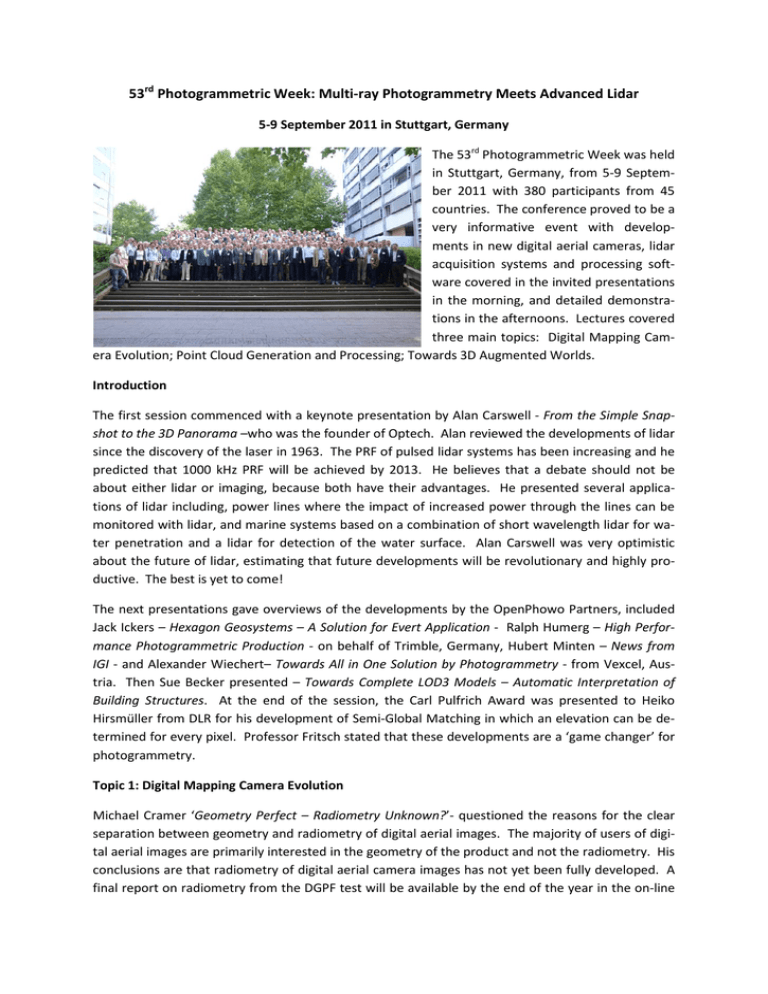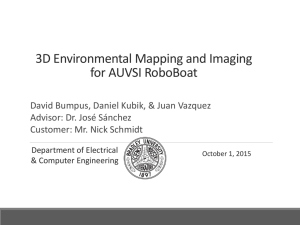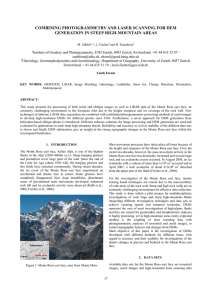53 Photogrammetric Week: Multi-ray Photogrammetry Meets Advanced Lidar
advertisement

53rd Photogrammetric Week: Multi-ray Photogrammetry Meets Advanced Lidar 5-9 September 2011 in Stuttgart, Germany The 53rd Photogrammetric Week was held in Stuttgart, Germany, from 5-9 September 2011 with 380 participants from 45 countries. The conference proved to be a very informative event with developments in new digital aerial cameras, lidar acquisition systems and processing software covered in the invited presentations in the morning, and detailed demonstrations in the afternoons. Lectures covered three main topics: Digital Mapping Camera Evolution; Point Cloud Generation and Processing; Towards 3D Augmented Worlds. Introduction The first session commenced with a keynote presentation by Alan Carswell - From the Simple Snapshot to the 3D Panorama –who was the founder of Optech. Alan reviewed the developments of lidar since the discovery of the laser in 1963. The PRF of pulsed lidar systems has been increasing and he predicted that 1000 kHz PRF will be achieved by 2013. He believes that a debate should not be about either lidar or imaging, because both have their advantages. He presented several applications of lidar including, power lines where the impact of increased power through the lines can be monitored with lidar, and marine systems based on a combination of short wavelength lidar for water penetration and a lidar for detection of the water surface. Alan Carswell was very optimistic about the future of lidar, estimating that future developments will be revolutionary and highly productive. The best is yet to come! The next presentations gave overviews of the developments by the OpenPhowo Partners, included Jack Ickers – Hexagon Geosystems – A Solution for Evert Application - Ralph Humerg – High Performance Photogrammetric Production - on behalf of Trimble, Germany, Hubert Minten – News from IGI - and Alexander Wiechert– Towards All in One Solution by Photogrammetry - from Vexcel, Austria. Then Sue Becker presented – Towards Complete LOD3 Models – Automatic Interpretation of Building Structures. At the end of the session, the Carl Pulfrich Award was presented to Heiko Hirsmüller from DLR for his development of Semi-Global Matching in which an elevation can be determined for every pixel. Professor Fritsch stated that these developments are a ‘game changer’ for photogrammetry. Topic 1: Digital Mapping Camera Evolution Michael Cramer ‘Geometry Perfect – Radiometry Unknown?’- questioned the reasons for the clear separation between geometry and radiometry of digital aerial images. The majority of users of digital aerial images are primarily interested in the geometry of the product and not the radiometry. His conclusions are that radiometry of digital aerial camera images has not yet been fully developed. A final report on radiometry from the DGPF test will be available by the end of the year in the on-line journal Remote Sensing. Rudi Wagner - LeicaADS80 and Leica XPro – A Total Solution for Photogrammetric Mapping – described the new sensor heads of the ADS80 and the high resolution mode comprising 24,000 CCD elements, which is not used very much at present, but may be used in the future. XPro is claimed to be the most integrated software on the market. It uses an innovative approach to aerial triangulation and times of processing are much reduced. 1200km2 of flying can be processed in 7 hours, with most of the time taken up with downloading the data. He also introduced details of the RCD30 medium format camera. Klaus Neumann – The Z/I DMC II – ‘Imaging Revolution’ -presented details of the new Z/I’s DMC II; the sensor come from DALSA with up to 250 Mpixels at 5.6µm. This is a world record for a digital sensor and is only available to Z/I. Two focal lengths are available, 92mm and 112mm. The format is nearly square; the angular field is 45.5° x 38.6°, leading to good B/H. There are 130 DMC II cameras in operation. Michael Gruber - UltraCam, A Brand for Continuous Developments - introduced the new version of the UltraCam Eagle with 260Mpixels (20100x13080 pixels 5.2µm in size) for panchromatic images derived from 4 lens cones and 4 lens cones for the multi-spectral images. The sensor head is integrated with UltraNav from Applanix. He then described the Bing Maps contributions to urban modelling, comprising 3D modelling from aerial and terrestrial photos. Version 3 of UltraMap software is currently being developed based on Sea Dragon technology and incorporates Microsoft software developments. Bernd Eisfeller - On-line GNSS Data Processing – Status and Future Developments -described methods of deriving position from GNSS and potential accuracies. He stated that in 10 years there will be 120 GNSS satellites and this will require changes in equipment to process the signals. Werner Mayr - Unmanned Aerial Systems in Use for Mapping at Blom - spoke on the use of the Swedish PAM SmartPlanes AB for mapping projects. The UAVs are 7kg in weight and highly mobile and can be operated by one person. They are only flown in visible range and have been used to acquire images with GSDs of 5 to 10 cm. Henri Eisenbeiss – The Potential of Unmanned Aerial Vehicles for Mapping also spoke on UAVs, especially helicopter systems. He described their advantages, as well as the limits on the size of payloads. Applications include for measuring gravel pits and cadastres. For accurate systems a stabilized mount is required. Jens Kremer – Power Line Mapping: Data Acquisition with A Specialized Multi-Sensor Platform - spoke of IGI’s systems for power line mapping for direct measurement of wires based on the Litemapper multi sensor platform, which includes lidar and a nadir looking DigiCam. The specifications of the Quattro DigiCam were also described. Other sensors can also be added to the platform. He gave an example of a project in Poland comprising ½ million images captured in 30-40 days. Marco Weber - TANDEM-X: A New Area Global Digital Elevation Data - spoke of Infoterra’s 3 year program to determine DEMs over the global land masses from the TANDEM-X SAR mission by interferometry. The DEMs will follow the US NGA’s specifications for HRTI-3 of less than 2m for terrain slopes less than 2°. The complete land mass must be covered twice to reach the accuracy specifications. Data will be available in 2013 with 12m intervals. Initial tests show a vertical accuracy of 1-2 m for 90% of points. Planning is already underway for the next generation of satellites. Konrad Schindler – Improving Wider-Area DEMs Through Data Fusion – Chances and Limits – described his studies of fusing DEM data from various sources with different accuracies, based on weighting systems according to the local DEM properties. DEMs from 5 sources of data were fused and the results compared with ground truth from lidar data with σ < 0.5m. The fusion resulted in significant improvements in accuracy of DEMs derived from optical satellite data. Fusion can assist in mitigating blunders which occur in large area DEMs. He raised the question of ‘what is a better DEM’? Topic 2: Point Cloud Generation and Processing. Heiko Hirschmüller - Semi-Global Matching – Motivation, Developments and Applications - spoke of his experiences in developing Semi-Global Matching (SGM), which is a new approach to acquiring elevations of every pixel. The method includes a smoothness cost function, derived from the field of computer vision. Various approaches to defining the cost function were tested, with the best results being obtained using Mutual Information and Census Implementations have been on GPU, FPGA and a super computer. He demonstrated a number of tests which have involved 120 TBytes of data so far, including satellite and aerial and UAV images. Norbert Haala - Multiray Photogrammetry and Dense Image Matching – referred to the number of pairs of images can be used for photography with 70% or 80% overlap along the strip and 60% across the strip, when there are potentially 45 stereo combinations. He tested the forward and backward matching as a measure of consistency. His implementation of SGM on a planar test area resulted in accuracies of matching of 0.14 to 0.25 pixels for different B/H. Multiray matching improves accuracy of matching and he suggested that pixel based bundle adjustment could be the next development. Tobias Heuchel – Towards a Next Level of Quality DSM/DTM Extraction with Match-T - described the capabilities of version 5.4 Match-T using multiple processors which can match 9x more densely than version 5.3. A matching rate of 12000 points/s is achievable. He demonstrated that people walking up stairs can interrupt matching of the stairs. Juha Hyyppä - State of the Art of Laser Scanning - said that lidar is used for forest inventories in Scandinavia, but not so much for individual tree detection. Trunk detection is carried out by TLS and MLS and better methods are now available for tree description. Full waveform lidar is expected to enable better determination of characteristics of trees. He also spoke of tests currently being undertaken on absolute and relative calibration of lidar intensities, which should improve the measurement of backscatter characteristics, spreading loss, transmitter power changes and the effects of the atmosphere. Andreas Ulrich - Echo Digitization and Waveform Analysis in Airborne and Terrestrial Laser Scanning - described the operations of the Riegl systems for discrete and waveform recording as well as methods of deconvolution. He also countered negative statements that have been given about full waveform data, which delivers the best resolution data as well as a number of additional attributes. Lewis Graham - Aerial and Mobile Point Cloud Integration – An Industrial Perspective - spoke of how lower resolution aerial lidar data can be compared with high resolution mobile lidar. Computing TINs from lidar is problematic when there are multiple returns from the same location. An approach to merging could be statistical merging, but the statistical details on errors in the data are not available. Hence he believes that interpolation from TIN data is a bad idea. Studies of DEMs should relate to sampling theory. Merging of DEMs should be based on signal processing methods. Ron Roth Leica ALS70 – Point Density Multiplication for High Density Surface Acquisition - described the rapid growth in lidar development over the past 7 years, although improvements in accuracies have recently levelled off. The limiting factors in airborne lidar are the GNSS component. Pulse repetition rates (PRF) are doubling roughly every 2 years. In 2009 the first dual output scanners were announced. The ALS70 dual output system is based on a single laser, scanner and receiver and doubles the scan rate and PRF. As well, it ensures that the dual outputs are separated on the ground if variations in flying conditions occur. He provided some examples of the flight parameters to achieve a PRF of 500 kHz. The topic of Point Cloud Generation and Processing was concluded with a panel discussion in which the speakers and other invited persons were asked such questions as: the unique selling points of lidar and size of lidar business; motivation to support lidar segment; image matching growth; why SGM and its strength and weaknesses; perception of the applications of aerial photos and lidar and when is the best applications for each; and Hexagon’s business strategy give its multiple camera systems. Topic 3: Towards 3D Augmented Worlds Jan-Michael Frahm - State of the Art and Challenges in Crowd Sourced Modeling - described the steps taken to extract appropriate crowd sourced images for modelling well known buildings. The progress in hardware development has enabled large numbers of images to be processed with multiple processors. In 2010, 3 million images could be processed on 1 PC in 24 hours. Some challenges have been largely overcome, such as scalability/speed, appearance resolution variability, but not model and location completeness. The future will be dynamic scene modelling including people and cars and scene understanding. Lyn Wilson - Two Avenues for Data: Rosslyn Chapel as a Terrestrial Scanner Case Study - described the laser scanning of the 15th century chapel in Scotland in which involved 4 billion points were acquired in 3 days. Bart Beers - Collection and Application of 2D and 3D Panoramic Imagery – described Cyclomedia image system based on 2 panoramic cameras with fisheye lenses. 85% of municipalities in The Netherlands are customers. Christopher Strecha – The accuracy of Automatic Photogrammetric Techniques on Ultra-Light AUV Imagery – described fully automatic processing of 3D landscapes. Finally Dieter Fritsch – Multi-Sensors and Multiray Reconstruction for Digital Preservation – described a low cost approach to imaging system using off-the-shelf equipment to accurately model The Dam in Amsterdam. He described the calibration of the cameras, triangulation by Structure and Motion as well as pixel-wise matching by a modified SGM approach. The expected spacing of points is 0.2-0.5mm with a standard deviation of 0.2mm to 0.4mm. The conference was ably chaired by Dieter Fritsch, who gave excellent summaries of each topic during the week. Proceedings have been produced in hardcopy and on DVD. The program, all papers and most of the presentations are available at: http://www.ifp.uni-stuttgart.de/phowo/2011/presentations/index.en.html John Trinder September 2011





